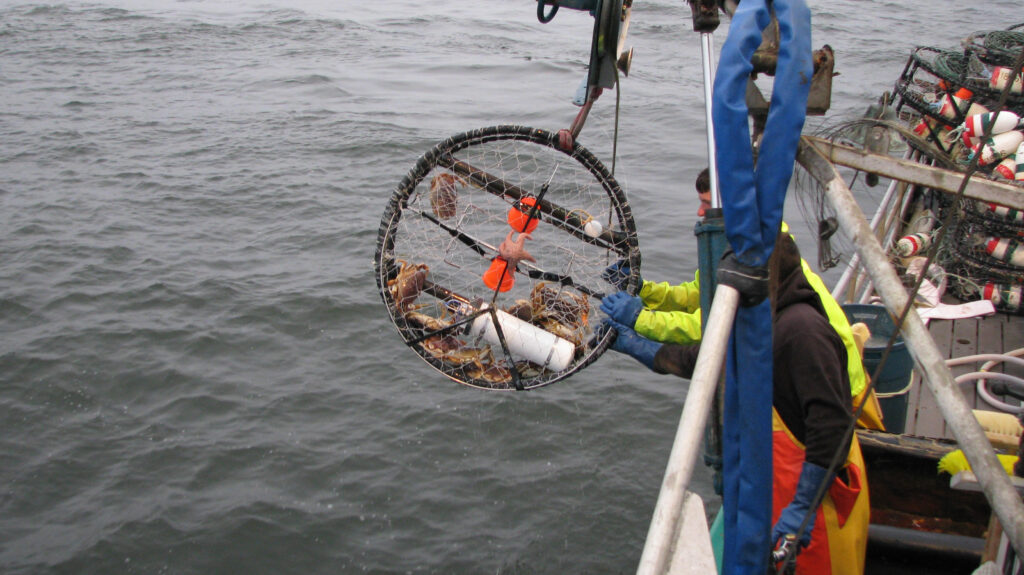Low oxygen or hypoxic zones have increased in the Pacific Northwest. We are working with Dungeness crab fishermen in Oregon to deploy dissolved oxygen sensors on commercial crab pots to help detect the onset of hypoxia events on fishing grounds. These difficult to track zones result in die-offs of marine life and are threatening the sustainability of important fisheries. This work will enable adaptive fishing and proactive management of fisheries in a changing ocean.

Why We Care
Along the U.S. West Coast, offshore oxygen declines and greater wind-driven coastal upwelling have exposed marine ecosystems to increased low oxygen stress. Hypoxic or low oxygen waters, also known as dead zones, can become lifeless areas, as mobile animals leave the area and those that cannot often die. Off the coast of Oregon, the Dungeness crab fishery is already feeling the early impacts of this intensification in hypoxia, as hypoxic zones increasingly form in areas that have traditionally been productive fishing grounds. The Oregon Dungeness crab fishery is one of the Pacific Northwest’s most important fisheries, accounting for an average of $39.5 million dollars annually for the past 20 years.
New information suggests that by changing the behavior and distribution of fishes, and their receptiveness to fishery-independent surveys, hypoxia can also affect the performance of the very tools that resource managers use to determine annual catch limits for a given fisheries stock. For example, recent demersal fish surveys in the Pacific Northwest have failed to catch fish over broad regions affected by hypoxia, increasing the uncertainty in the ability to accurately assess stock status. Policymakers and fishermen have expressed concern, and key questions about hypoxia and fisheries remain, including: (1) how does the formation of shelf hypoxia overlap with fishing grounds and essential fish habitat?, (2) what are the impacts to fisheries from the overlap with hypoxia?, (3) what are the thresholds for biological impacts, and how do those thresholds differ among species?, and (4) how is hypoxia affecting fishery-independent surveys designed to assess stock status?
What We Are Doing
We are working with Oregon’s Dungeness commercial crab fishery to cooperatively implement a hypoxia detection and monitoring program. We will deploy 40 dissolved oxygen sensors on commercial crab pots in collaboration with commercial fishermen. The information collected with these sensors will supply hypoxia exposure data that will allow the fishing fleet to adapt to the onset of hypoxia events and the Oregon Department of Fisheries and Wildlife Shellfish Program managers with the ability to conduct in-season management of the fishery. This information will also enhance our ability to quantify hypoxia thresholds for fisheries impacts, and validate high-resolution models developed to define hypoxia exposure and vulnerability across the Pacific Northwest. Our objective is to develop an in-season forecast (1–7 days) of hypoxia risk based on the sensor data.
We will also be integrating the dissolved oxygen measurements from the crab pot sensors into survey methods and models used by NOAA’s West Coast Groundfish Trawl Survey and Oregon’s Department of Fisheries and Wildlife Marine Resource Program. Thus, allowing resource managers to explicitly identify the effects of hypoxia on fishery-independent survey data and develop tools that would enable managers to account and adjust for the effects of hypoxia on survey estimates used for determining stock status.
This project is part of the Coastal Hypoxia Research Program, and is led by Francis Chan at Oregon State University. To ensure that our project and its outputs are useful to managers, we will work closely with resource managers at the Oregon Department of Fisheries and Wildlife and NOAA to translate our results.
